Nicaragua 22 December 2009 to 5 January 2010
"Licencia, licencia, licencia" demanded the motorcycle cop who'd whistled us to a stop on the outskirts of the capital city Managua. Our crime was apparently to cross over an imaginary line on a deserted roundabout on a Sunday morning. I went dumb, and left Pat to undertake negotiations with her three words of Spanish and we went into a double act of not understanding what was going on at all. We knew that Nicaraguan police have the right to take your licence but were hazy about what happens next.
Over the next 45 minutes under a very hot sun, we discovered he wanted us to pay a fine of a thousand cordobas (approx $50 each). He would keep our licences and give us a yellow ticket. We have to take the ticket to a bank and pay the fine, then take the receipt to an office somewhere in Managua and swap it for our licences.
After he's laboriously drawn us a map of where that office is and Pat's wailed no banco, Sunday and anyway we're en route to somewhere else, he quietly asks in Spanish if we'd like to pay today........ I ignore this bribery approach and watch spellbound as Pat crumples to the ground, demands water and pours it over her head. Muy caliente, muy caliente she says and he looks aghast (Pat has no idea shes said she's gagging for it, rather than that she's overheating). I stroke her shoulder and look concerned. He gets his mobile out either to call for help for himself or to call for a doctor.
Fortunately Pat stages a quick recovery, at which point he gives up the unequal struggle and hands our licences back. We thank him profusely and then persuade him to lead us right through Managua (at double the speed limit) and onto the right road. And the best bit? They're not our actual licences, but bright green miniature laminated photocopies that we'd had done for just such an eventuality. It was however a bit unnerving and we were paranoid about police throughout Nicaragua as a result.
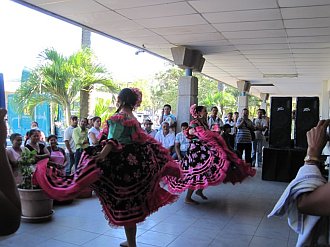
Xmas celebrations at the Nicaraguan border crossing. No wonder it all took so long.
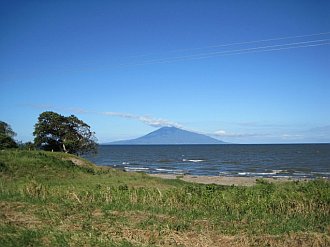
First view of Nicaragua Volcano on Ometepe Island
The police episode apart, Nicaragua was lovely. We spent five blissful days over Christmas at the Crater's Edge Hostel on the edge of the beautiful Laguna de Apoyo. Interesting fellow travellers, good food, swimming in the warm, crystal clear, slightly sulphurous water of the crater, kayaking and kingfisher spotting and generally relaxing.

Testing the waters at Craters Edge
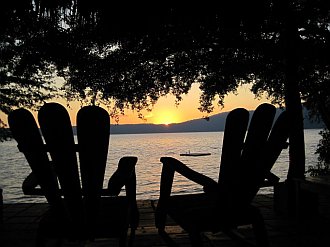
Sunset at Craters Edge
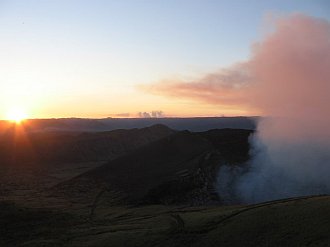
Volcan Masaya near Craters Edge
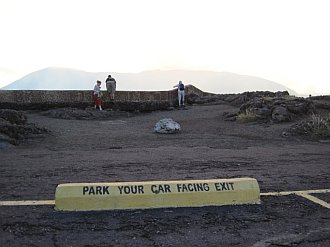
In case you forget this is a live volcano
No silent night at Christmas the midnight arrival of baby Jesus in this intensely Catholic nation is marked by half an hour of ear-shattering bombas or firecrackers. The noise is the thing Nicaraguans don't care about firework displays.
Our next stop was the Sandinista stronghold of Leon. Lovely old colonial city in varying stages of decay and restoration, bullet holes still visible in places where resistance was strong against the American-backed Contras in the late 1970's. After closing time one evening, we managed to blag our way into the Sandinista museum and were proudly shown round by a very enthusiastic loyal ex-guerrilla. He pointed out on yellowing newspapers stuck to the walls, the photos of heroes of the resistance who had either been shot or who had shot the oppressors.
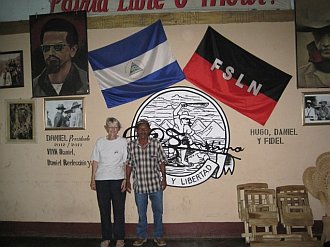
The Sandinista Museum. He seems harmless enough now .
Thick black stencils linking the names of Daniel, Hugo and Fidel can be seen all over the city. For a child of the left-wing sixties, I was transported back to my youth and found this all impossibly romantic! Pat, being more pragmatic, was unmoved.
Daniel (Ortega) is the current President of Nicaragua and is busy altering the Constitution illegally so as to allow himself a third term in office at the next election. Graffiti we saw repeated throughout the region say Re-eleccion = Dictactura (re-election is dictatorship), so not everybody is in favour. Hugo (Chavez) is President of Venezuela and the USA's current South American bête noire he's recently devalued the currency, nationalised a French owned supermarket and is busily scrapping militarily with Colombia, into which the Americans are pumping men and money in the drugs war. Fidel is of course Castro.
The Latin American bad boys
Leon is also famous for its stunning museum, Fundacion Ortiz Guardian, full of art and sculpture from all over Central America from the Middle Ages to the present day. The modern sculptures were particularly good and the museum is said to be the best in Central America.
We left Leon reluctantly and headed north towards the main coffee growing region, diverting for a night to the cloud forest.
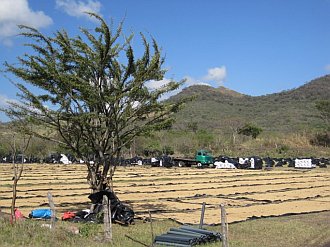
Coffee drying industrial scale
Coffee husking small farm scale
The cloud forest visit involved 30 km of bone-shaking riding up a brutally rocky, gravel road to Finca Neblina del Bosque, the last bit up a steep muddy slope. Heart in mouth we made it safely. At the top was a paradise of open sloping fields and a warm welcome from the couple who run it. Isobel is German and Eduardo is Nicaraguan and they've hand-built the place themselves from scratch.
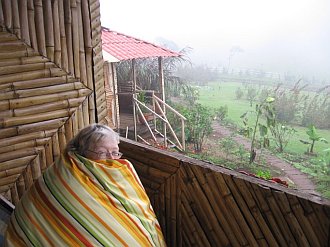
It's cold in the cloud forest
We had a peaceful cabaña with resident chameleon, wonderful views, especially of the cloud as it swirled in over the valley, and three wonderful vegetarian meals for $25 apiece. Oh and five adorable puppies that gambolled round our feet when we set off for a walk. People in the surrounding area are very poor and the Finca employs as many as possible to tend the bananas and coffee they grow. They also fed 300 children over Christmas and plan to build a school locally as well and set up a market garden to provide employment.
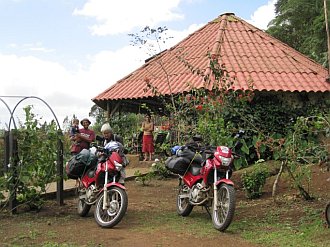
Setting off from the Finca
Having discovered there was a new (though still dirt) road back to the main highway, we took that one and only had to negotiate some large puddles and hairy slopes and soon arrived in Matagalpa. We holed up for New Year in a hotel full of Americans who'd flown in for four days to distribute toys to a group of mission schools in the area. There was still a vast mound of toys in the lobby when they noisily left at 4am to catch their plane back to Miami.
Wandering round town next day, we noticed a number of house porches sporting a Guy dressed in old clothes this is El Viejo the old man and at midnight El Viejo is taken into the street and ceremoniously burnt. He represents all the disappointments and failures of the old year, so people can start the New Year afresh.

El Viejo
Nobody invited us to any parties and there didn't seem to be anything happening so we were fast asleep by 11pm. Midnight and all hell broke loose it was the bombas again for a full thirty minutes. This set all the dogs barking which woke up all the cockerels who normally start their dawn chorus at about 4am.....
Somewhat wearily the next day we loaded up and left town. Our final stop in Nicaragua was Somoto and its famous Canyon. We hired a guide and hiked a couple of hot kilometres down into the canyon. In the distance was the unmarked border with Honduras, which we were told was full of drug smugglers and very dangerous. Pat picked up an orchid plant that had fallen out of a tree and a swarm of wasps flew out, one of which stung our guide, but fortunately not Pat. He was very brave and didn't whimper at all.
The canyon got extremely narrow and soon we were paddling and finally floating in our life-jackets down the river, idyllic after the hot walk.
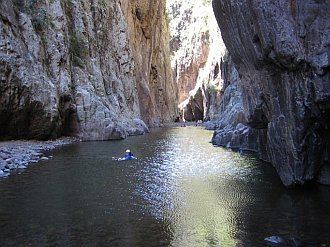
Floating down the Canyon de Somoto
Fortunately we'd taken dry bags for our cameras and binoculars, as the dry box our guide had brought for our benefit had a large hole in it and our rucksacks and clothes just floated around inside the box as he pushed it down the river. Luckily for him we could store his mobile in one of our bags. Apart from one part of the canyon, which was heaving with Sunday trippers, we had the whole place almost to ourselves. Finally we got into a rowing boat for the last section and then walked out of the canyon to our waiting taxi. It was a great finale to our stay in Nicaragua. Only a pity that being Sunday, all the restaurants were shut so we ate from a street stall and it was either that or swallowing canyon water that gave me the runs for the next week.
